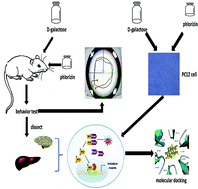Phlorizin exerts potent effects against aging induced by d-galactose in mice and PC12 cells†
Abstract
Phlorizin is the main active ingredient of apple peel and has potential utilization value. Some recent studies have suggested that phlorizin may have antioxidant capacity and protect the liver. The injection of a low dose of D-galactose can cause some changes that resemble accelerated aging in mice. This study explored the protective effects of phlorizin on D-galactose-induced mice and PC12 cells. In this study, ICR mice were divided into a normal group (NOR), a D-galactose model group (D-gal) and phlorizin treatment groups (100 mg kg−1, 200 mg kg−1 and 400 mg kg−1). In addition to the NOR group, four other groups were injected with D-galactose (120 mg kg−1) for 12 weeks. The results showed that phlorizin reduced the decline of strength, coordination and spatial memory caused by aging, increased the activity of superoxide dismutase (SOD), catalase (CAT) and glutathione peroxidase (GSH-Px), increased total antioxidant capacity (T-AOC), and reduced the content of malondialdehyde (MDA). On the other hand, phlorizin increased the levels of interleukin-2 (IL-2) and acetylcholine (ACh), reduced the release of interleukin-6 (IL-6), aspartate aminotransferase (AST) and alanine aminotransferase (ALT), and decreased the activity of acetylcholinesterase (AChE) in the brain, improved the expression of antioxidant genes related to the nuclear factor E2-related factor 2 (Nrf2) pathway, and reduced the occurrence of morphological lesions in the hippocampus and liver. In addition, phlorizin improved cell viability and reduced the cytotoxicity of D-galactose-induced oxidative stress in PC12 cells. Meanwhile, the protective effect of phlorizin was abolished in Nrf2 gene knockdown PC12 cells. Furthermore, molecular docking showed that phlorizin could bind Keap1 protein, which can interact with Nrf2 protein. Therefore, these results suggest that phlorizin may delay senescence and enhance antioxidant capacity through the Nrf2 pathway.



 Please wait while we load your content...
Please wait while we load your content...